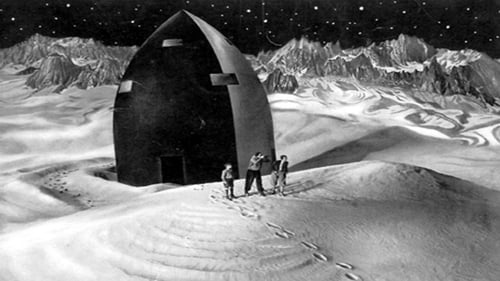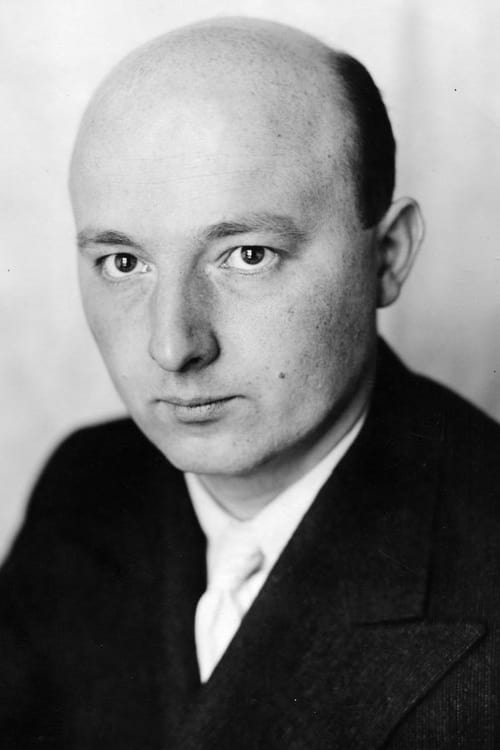Oskar Fischinger
출생 : 1900-06-22, Gelnhausen, Germany
사망 : 1967-01-31
약력
Oskar Wilhelm Fischinger (22 June 1900 – 31 January 1967) was a German-American abstract animator, filmmaker, and painter, notable for creating abstract musical animation many decades before the appearance of computer graphics and music videos. He created special effects for Fritz Lang's 1929 Woman In The Moon, one of the first sci-fi rocket movies. He made over 50 short films, and painted around 800 canvases, many of which are in museums, galleries and collections worldwide. Among his film works is Motion Painting No. 1 (1947), which is now listed on the National Film Registry of the U.S. Library of Congress.
Description above from the Wikipedia article Oskar Fischinger, licensed under CC-BY-SA, full list of contributors on Wikipedia.

Director
3-screen experimental animation

Director
Compilation of abstract animated films by Oskar Fischinger; includes his short films Spirals, Spiritual Constructions, Study 6, Liebesspiel, Radio Dynamics, and Motion Painting No. 1.

Director
Motion Painting No. 1 is a 1947 experimental short animated film in which film artist Oskar Fischinger put images in motion to the music of Johann Sebastian Bach’s Brandenburg Concerto no. 3, BWV 1048. It is a film of a painting (oil on acrylic glass); Fischinger filmed each brushstroke over the course of 9 months. In 1997, this film was selected for inclusion in the United States National Film Registry by the Library of Congress as being “culturally, historically, or aesthetically significant”.

Director
A short experimental film.

Director
An mutoscope motion picture installation commissioned for the 86th anniversary of the Guggenheim museum. Later preserved and turned into a short film.

Director
An experiment into what the director termed 'colour rhythm'.

Director
An experiment in color and rhythm with no music.

Director
a short animation from Oskar Fischinger, drawings with periodic colour coding and some cells completely painted.

Director
Stars and stripes forever and ever and ever.

Writer
Abstract animation.

Director
Abstract animation.

Director
A dance of shapes. A title card tells us this is an experiment in conveying the mental images of music in a visual form. Liszt's "Second Hungarian Rhapsody" is the music. The shapes, all two-dimensional, are circles primarily, with some squares and rectangles, and a few triangles. The shapes move rhythmically to the music: receding from view or moving across the screen. Red circles on a blue background; light blue squares; white rectangles. Then, a red background of many circles with a few in the foreground. Red gives way to blue then to white. Shapes reappear as Liszt's themes re-occur. Then, with a few staccato notes and images, it's over.

Director
In the 1936 short Allegretto, diamond and oval shapes in primary colors perform a sensual, upbeat ballet to the music of composer Ralph Rainger. The geometric dance is set against a background of expanding circles that suggest radio waves.

Director
An abstract film in which every motion of coloured shapes is in strict synchronization with music

Director
Animated cigarette advertisement.

Director
The black and white, live-action Swiss Trip, scored with Bach's 3rd Brandenburg Concerto (like Motion Painting No. 1), is kind of a nature or travel film cut via noticeable (in-camera?) edits that give the impression the film is constantly blinking and foreshadow techniques Stan Brakhage would use in the '50s and '60s.

Director
A continuous movement

Director
An animated experimental film showing coloured circles moving to classical music, which only got past the 1934 censors billed as a commercial.

Director
Muratti was a German brand of cigarettes. Fischinger transforms bunches of standing cigarettes into things that resemble human beings. At first they walk daintily around packages of Muratti tins. Gradually as the film progresses their motions become more graceful, as they do "slides" and other motions and formations associated with dance. The apotheosis of the film is remarkable: Dozens and dozens of cigarettes, arranged in Busby Berkeley-like fashion, repeatedly bow to the horizon, where a giant sun labeled "Muratti" rises in response to to their worshiping activity.

Director
Experimental short film by Oskar Fischinger

Director
One of the first color films in Europe, made with the Gaspar Color process.

Director
Experimental short film by Oskar Fischinger

Director
Fischinger's abstract designs accompanied by Gitta Alpar singing.

Director
Curious and intrigued by technological advances, Fischinger here also experiments with "synthetic sound" (he would not be the only one: later Norman McLaren played a lot with it). Thus he contructed the optical sound track directly onto the film. But beyond identifying harmonics and noises, he sought to understand to what sound emissions corresponded the geometrical and regular designs which, visibly, appear in their turn synchronously on the screen as true and proper "ornaments" of the sound which is being produced.

Director
An abstract set to "Merry Wives of Windsor" by Nicolai.

Director
An abstract to music from "Eine Kleine Nachtmusik" by Mozart.

Director
An abstract to music from "Aida" by Verdi.

Director
An experimental abstract animation.

Director
An experimental short from Oskar Fischinger

Director
An experimental short from Oskar Fischinger

Director
An experimental short from Oskar Fischinger

Director
The first Studies were synchronized with records (Fischinger made a total of 13 Studies all without sound). It was only with the introduction of sound, beginning with Study No 6 that the films did full justice to this musical principle. The play of the white lines, the arcs, and the upside-down U’s running hither and thither like ballet dancers was brought into perfect synchronization with the music, and thus the films offered an abstract illustration of the melodies. Study No 6 is certainly the best of his films in terms of forms. - Hans Scheugl and Ernst Schmidt, Jr.

Director
An abstract ballet set to "I've Never Seen a Smile Like Yours".

Director
Experimental short film by Oskar Fischinger

Director
A work of abstract animation

Director
Directed by Oskar Fischinger.
Germany, 1930, 35mm, black & white, silent, 2 min.

Director
A work of abstract animation

Special Effects
달에 금이 있을지도 모른다는 만펠트 박사의 가설에 흥미를 느낀 모험적인 사업가 헬리우스는 동료들과 함께 달 여행을 준비 중이다. 하지만 또 다른 사업가들의 음모로 헬리우스는 여행에 필요한 자료들을 도난당하고, 결국 헬리우스는 음모를 꾸민 자들과 함께 우주선에 승선한다. ‘스페이스 오페라’의 청사진으로 여겨지는 프릿츠 랑 감독의 두 번째 SF 영화. (2019년 한국시네마테크협의회 - 독일 SF 특별전 - 미래는 어떻게 만들어지는가?)

Director of Photography
달에 금이 있을지도 모른다는 만펠트 박사의 가설에 흥미를 느낀 모험적인 사업가 헬리우스는 동료들과 함께 달 여행을 준비 중이다. 하지만 또 다른 사업가들의 음모로 헬리우스는 여행에 필요한 자료들을 도난당하고, 결국 헬리우스는 음모를 꾸민 자들과 함께 우주선에 승선한다. ‘스페이스 오페라’의 청사진으로 여겨지는 프릿츠 랑 감독의 두 번째 SF 영화. (2019년 한국시네마테크협의회 - 독일 SF 특별전 - 미래는 어떻게 만들어지는가?)

Director

Director
Never-released early experiments, animation drawings and tests from Oskar Fishcinger

Director
One of Oskar Fischinger's earliest films, Seelische Konstruktionen (as it is known in German), clearly points the way to the masterpieces of musically-blended experimental animation he would conceive in the decades to come. The sense of masterful timing and rhythm, the easy and natural -- though patently Fischinger-esque -- character traits of the subjects, and the smooth precision of both line and movement are all present already. Unique is the black-silhouetted, semi-cartoon characters (not nearly as rigidly self-contained as Lotte Reiniger's cut-out forms) which seem to adhere to no physical limitations whatsoever. Morphing into shapes, structures, objects, patterns, and even one another, as though they were made of pure mercury and set to music. As for the "story", it's rather non-sensical, and certainly silly, but also has a slightly dark and devious tinge to it as well; men becoming monsters, uncontrollable shape-shifting and the constant, almost desperate movement.

Director
For the production of this film, Oskar Fischinger tinted various layers of hot wax. After cooling, the resulting lump of wax resembled a marble cake. Fischinger then began to cut off slices from the lump, photographing each step.

Director
In 1927, motivated by a longing for freedom, Fischinger set off on a walking trip from Munich to Berlin. Covering the distance in nearly four weeks, he captured the country’s hidden beauty. His voyage serves as a symbolical transition and underlines a belief that people are the same everywhere.

Director
Directed by Oskar Fischinger.

Director
Parallel bars moving up and down in rhythmic patterns.

Director
In 'Spirals' Oskar Fischinger designed visual patterns of extreme complexity which often develop in overlapping cycles, yet he interrupts these patterns with radical editing of single frames of contrasting imagery. 'Spirals' exists as a fragmentary unfinished experimental film.

Director
What remains, unedited, of the first episode of a serial by several hands, subject to a form of supervision-control by Fischinger. It opens with an extremely happy image (a "creative hand" which subsequently returns from time to time) — with shading and movements which appear to have been achieved by the use of the Rotoscope — characters who evoke the commedia dell’arte, in a somewhat joyless tone, but visually dramatic and with echoes of "caligarism". Enno Patalas would like to visit the other surviving episodes, better to understand the spirit of the operation conceived by Louis Seel, designer emeritus and the inspiration of the project.




